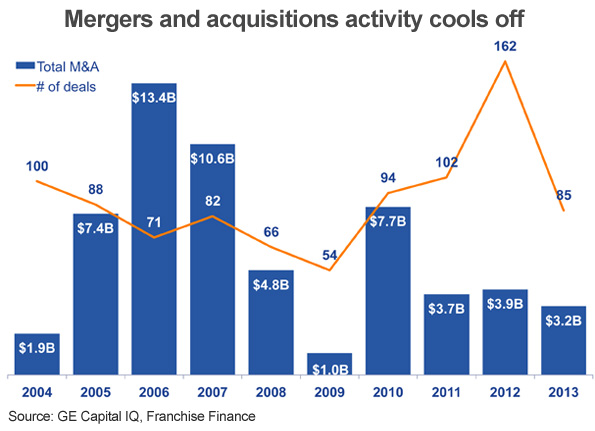An uneven economic recovery and concerns of higher labor and commodity costs this year are threatening to dampen restaurant operator optimism, according to the annual GE Capital Franchise Finance, or GEFF, review of the Chain Restaurant Industry.
However, restaurant operators are finding opportunities in new subsegments, such as fast-casual pizza, and by tapping new technologies to improve the customer experience. Many are also finding success by reworking menus with fresher, higher-quality and more healthful dishes, the GEFF report said.
“Wealth is coming back, but it’s an uneven distribution of wealth,” said Kimberly Savilonis, senior vice president, strategic marketing, for GEFF. “Everybody’s talking about the economy doing better, but you’ll hear positives and negatives.”
RELATED
• NRA: Operators maintain positive outlook in February
• Restaurant sales growth slows in 2013
• More restaurant finance news
The annual review takes a broad look at the economy and factors that have contributed to softer traffic trends over the past year. While unemployment dropped to 6.7 percent — below 7 percent for the first time since 2008 — real disposable personal income, or DPI, grew only 0.7 percent in 2013.
Gains were seen primarily in the equities and real estate markets, which means many consumers are not sharing in the benefits. Equities, for example, have recovered 171 percent of recession losses, but only 54 percent of individuals own stock, and those who do tend to be in higher-income households. About 65 percent of Americans own homes, but home values have only recovered about 55 percent of their total losses, the report said.
Higher-income families are driving any increase in spending. Based on income, households within the top 20 percent were responsible for about 90 percent of the increase in inflation-adjusted consumption between 2009 to 2012. The top 5 percent of households have increased their spending 17 percent since 2009, while the bottom 95 percent have increased spending by just 1 percent.

“Then you look at where they spent their money,” said Savilonis. “Auto loans are at an eight-year high in 2013. Student loans quadrupled in the last 10 years.
“Delinquency rates for credit cards declined — consumers are getting that under control. But those seriously delinquent on student loans have increased,” she continued. “The student population as a whole has increased. They’re not making as much money and not spending as much money.”
Restaurant chains, however, rely heavily on middle-income households. Not surprisingly, restaurant traffic declined last year, though total sales grew 3.1 percent in 2013, the report said.
“When you look at operators, even though they’re feeling more confident about the future, their confidence about the current situation has dropped because of softer traffic trends,” said Savilonis.
While merger and acquisition activity in the industry has declined, there are a growing number of lenders willing to provide cash for restaurant chains to grow, said Savilonis. “The capital is available. It’s whether the sellers and buyers can reach an agreement about the value of the company.”
This year, restaurants are turning to technology, including touch-screen tablets, mobile ordering and payment, and social media, to better connect with their customers.
“Although success has varied among brands, these trends will likely continue over the next few years as over two-thirds of restaurant operators are deploying more social media resources in 2014,” the report said.
Commodity costs, especially beef prices, are a concern this year, as are rising labor costs, with the minimum wage increasing in various states.
Savilonis warned that restaurant chains will need to work harder to keep their employees as unemployment declines and jobs become more available. In 2008, turnover within the industry was about 126 percent, she said. Prior to the recession it was about 147 percent, but now it’s about 102 percent.
“As unemployment goes down, turnover goes up,” she said. “Employers need to look at the benefits they provide and what they can offer employees to keep them.”
Contact Lisa Jennings at [email protected].
Follow her on Twitter: @livetodineout

